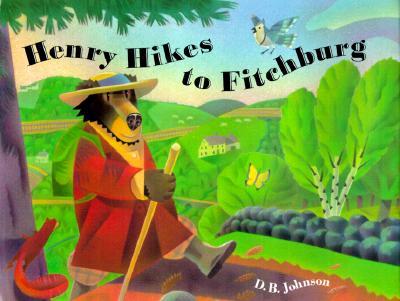 |
| Houghton Mifflin Books for Children |
|
Our Winning Book Synopsis:
This is the story of two suave yet friendly bears who, on a warm summer's day, decide that they'd really like to see a bit more of the country this summer. Eventually, both agree that they'll travel to a town that lies 30 miles away, a place named Fitchburg. The main character is a bear named Henry who decides he will walk to Fitchburg--while his nameless ursine friend opts to perform a series of odd jobs so he can later take the train and zoom to Fitchburg to win the race. Each expects to get there first. Which bear do you think will win?
This is a story at many levels. At one level, it is a version of the fabled tortoise-and-hare escapade. But isn't the ending obvious here? Trains can surely go faster than a person who walks. It seems like the railroading bear should win easily--but please be reminded that he first has to earn the money needed to pay his train fare to Fitchburg. Henry sets off a-hiking immediately, while his friend begins work at his first job--launching his extended quest to earn the price of the train ticket.
With every swoosh of the page, the young reader can sequentially compare and contrast what each of the two bears is doing. For example, Henry is hopping across streams on the rocks that stick out; spending time contemplating and making-do, carving his own walking stick; collecting ferns and flowers, and pressing them in his field notebook; using his hand lens to examine living organisms while strolling atop stone field walls; climbing trees and using his little telescope to see which way to walk next; making and paddling his very own river raft; discovering a bird's nest full of eggs, and eating from a honey tree; swimming in a pond; and feasting on wild blackberries enroute. Meanwhile, his friend is performing the hard physical labor that his various bosses tell him to do--work such as lifting and packing wood, sweeping floors, yanking garden weeds, painting fences, and moving bookcases. In the end, his friend actually does arrive at Fitchburg a little earlier than Henry--but Henry quips, "I know. I stopped for blackberries."
Long ago, was there really such a man like Henry? Did he really know people named Mrs. Alcott, Mr. Emerson, Mr. Hawthorne, and Mrs. Thoreau? Did he really talk about going to Fitchburg, Massachusetts? Read the biographical information on the last page of the book and you will learn that this children's book was actually inspired by a specific passage in the book WALDEN, written by Henry David Thoreau, the famous American writer, philosopher, and naturalist (1817-1862). Parents and teachers are thus primed and free to layer-on additional meanings in its later readings. Our award committee's hope is these little follow-up conversations will include more fascinating ideas from Thoreau the naturalist, the outdoors-person, the nascent ecologist, and the avid gardener!
We also like the fact that the walking bear's mileage is included quite unobtrusively throughout the book, so that this becomes a little mathematics exercise for children too. Can we figure out how far Henry has come since our last sighting? How many miles does he have left to travel? When did he make his most progress? And how did the money his friend was earning add up during the story? Which job paid the most?
But wait! Is "progress" to be measured in money, or miles, or in smiles? Immersion in the great outdoors, camaraderie with plants and animals, experiencing the tiny and unexpected joys of nature, gaining respite from the urban crowds, giddy freedom from preordained schedules, time for solitude and reflection, the satisfaction of living off the land, lots fresh air and exercise at a well-modulated pace--that's what Henry had that his friend did not. While some might say this book teaches children NOT to respect honest employment, we disagree. On the contrary, we think it suggests that the unexamined life, lived increasingly separate from nature, with its maximization of income and unquestioned use of technological advances, may not be as desirable, or as healthy, or even worth living at all. But this book does not moralize--it merely plants the seeds for such later self-questioning, and opens conversational windows for subsequent discussion with co-readers.
Donald B. Johnson is not only a fine storyteller who drinks from the well of history, but also an accomplished illustrator--with an impressive artwork resume in mass media. Thus not all the data in this book are numeric--visual data abound! There are many kinds of plants and animals for children to spot within page scenes throughout the book--and we have noted that the markings on the birds, for example, are surprisingly accurate--even when rendered in the fanciful, geometric, angular, folk-cubist style that Mr. Johnson has developed and perfected. The book's artwork reflects a "signature" union of colored pencil and paint on paper. It first draws the reader to the book's cover, and then to its story. We think his colors are "vividly subdued," and his parade of images gives the impression of smooth optic flow to match the docu-dramatical narrative's flow and textual rhythms. It has also not escaped us that Donald Johnson's words and pictures deftly invite the reader to study the life sciences and to botanize!
Read this book to a child and we predict you will soon turn off your cell phone, go hiking again, become a more careful observer of the natural world, rediscover the zero-cost, yet amazing, wonders of your own childhood, and perhaps re-examine the current quality of your own life, Thoreau-style.
|